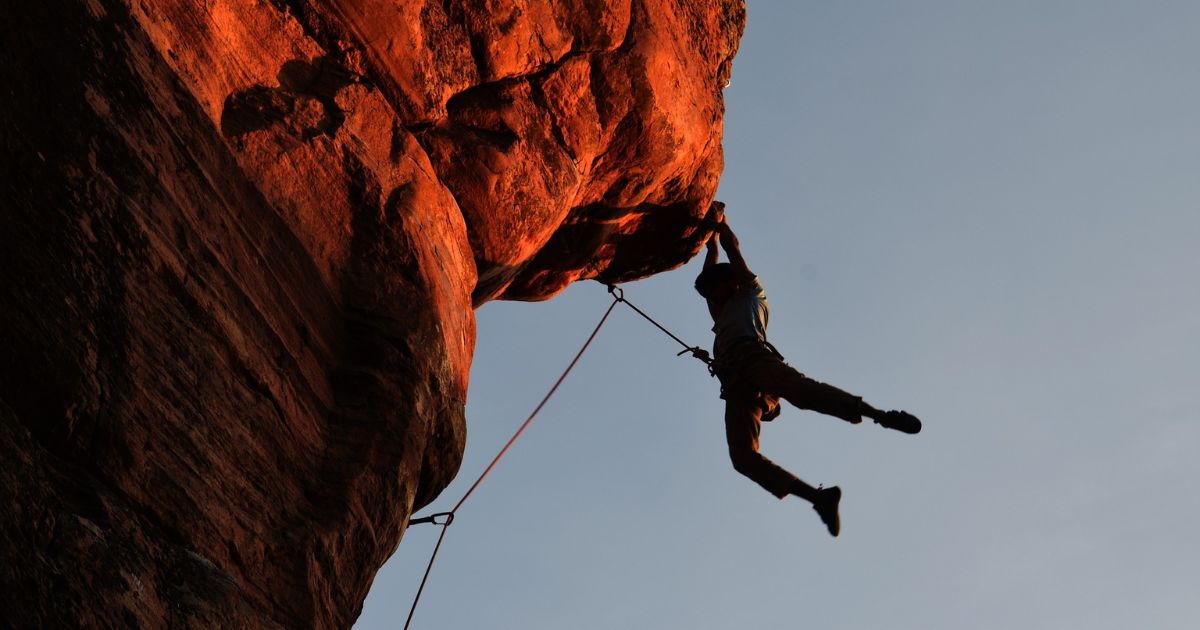Imagine standing at the base of a towering rock face, your heart pounding with anticipation. As you prepare to embark on your ascent, one question lingers in your mind: what is a pitch in rock climbing? Fear not, for this article will unravel the mystery. A pitch, in the realm of rock climbing, refers to a specific section of a route that can range in length and difficulty. Understanding the intricacies of pitches is crucial for climbers seeking to conquer challenging routes and elevate their skills to new heights.
Key Takeaways
- A pitch in rock climbing refers to a specific length or section of a climbing route, defined by its own unique characteristics and difficulty.
- Pitch length options and climbing techniques required are the components of a pitch.
- Factors such as route difficulty, physical demands, complexity, safety considerations, and protection availability affect pitch length.
- Pitches play a crucial role in organizing climbing routes, facilitating communication and teamwork, and ensuring a successful and safe climbing experience.
Definition of a Pitch
A pitch in rock climbing refers to a specific length or section of a climbing route. It is a fundamental unit of measurement that describes the progression of a climb. Each pitch is typically defined by its own unique characteristics, including pitch difficulty. Pitch progression refers to the order in which pitches are climbed, with climbers ascending one pitch at a time until they reach the top of the route. Rock Climbing Burn Calories is an additional benefit of this physically demanding activity.
The difficulty of a pitch can vary, depending on factors such as the steepness of the terrain, the presence of holds, and the complexity of the moves required. Understanding the difficulty of each pitch is crucial for climbers to plan their ascent and ensure they have the necessary skills and equipment. With a clear understanding of pitch progression and difficulty, climbers can confidently navigate through the components of a pitch in a safe and efficient manner.
Components of a Pitch
The components of a pitch in rock climbing include the pitch length options and the climbing techniques required. Pitch length options refer to the distance between belay stations, which can vary depending on the route and the difficulty level. Climbing techniques required may include specific movement skills, such as crack climbing or face climbing, as well as the ability to manage gear placements and route finding. Understanding these components is essential for climbers to plan their ascent and ensure a successful and safe climb.
Pitch Length Options
When considering pitch length options in rock climbing, climbers must carefully assess the components of a pitch. Varying pitch lengths offer different challenges and opportunities, allowing climbers to tailor their ascent to their preferences and abilities. Here are four key components to consider when deciding on the length of a pitch:
- Difficulty: Longer pitches often require more endurance and technical skill, while shorter pitches may be less physically demanding but require precise moves or difficult maneuvers.
- Protection: Longer pitches may require more gear placements and anchor points, ensuring a safe ascent. Shorter pitches may have less opportunity for protection and require careful planning.
- Time: Longer pitches take more time to complete, requiring climbers to manage their energy and resources accordingly. Shorter pitches allow for faster climbing and potentially more routes in a single day.
- Experience Level: Beginners may prefer shorter pitches to gradually build their skills and confidence, while experienced climbers may seek out longer, more challenging pitches to push their limits and test their abilities.
Climbing Techniques Required
Considering the pitch length options in rock climbing, climbers must carefully assess the components of a pitch, including the climbing techniques required. The climbing techniques employed during a pitch largely depend on the difficulty of the climb, the type of rock, and the style of ascent. For shorter pitches, climbers often rely on efficient movement techniques such as smearing, edging, and jamming to ascend quickly and minimize energy expenditure.
On longer pitches, climbers may need to employ endurance techniques such as pacing themselves, conserving energy, and finding rest positions. Additionally, more advanced climbing techniques like crack climbing, stemming, and slab climbing may be necessary to navigate specific sections of the pitch. It is essential for climbers to have a solid understanding of the climbing techniques required for each pitch length option to ensure a safe and successful ascent.
Importance of Pitches in Climbing
In rock climbing, pitches play a crucial role in organizing climbing routes and ensuring efficient progression. They serve as key points of reference for climbers, allowing for effective risk management strategies to be implemented. Furthermore, pitches facilitate clear communication and teamwork among climbers, enhancing safety and coordination during the ascent. Overall, understanding the importance of pitches is essential for a successful and safe climbing experience.
Climbing Route Organization
One crucial aspect of rock climbing is the organization of climbing routes into distinct pitches. Pitch organization and route management are essential for a safe and efficient climbing experience. Here are four reasons why this organization is important:
- Safety: Breaking a climbing route into pitches allows climbers to tackle one section at a time, minimizing the risk of fatigue and accidents.
- Communication: By dividing the route into pitches, climbers can easily communicate and strategize their actions, ensuring a smooth ascent.
- Skill development: Pitches provide opportunities for climbers to practice specific techniques and improve their climbing abilities gradually.
- Time management: Breaking a route into pitches helps climbers plan their climbing time and rest periods, optimizing their performance and overall climbing experience.
Through careful pitch organization and route management, climbers can navigate the challenges of a climbing route effectively and experience a sense of belonging in the climbing community.
Risk Management Strategies
Effective risk management strategies are critical in rock climbing, and the organization of pitches plays a crucial role in ensuring a safe and successful climbing experience. Prior to attempting a pitch, climbers must perform a thorough risk assessment to identify potential hazards and develop appropriate mitigation measures.
This involves evaluating factors such as the difficulty of the climb, the condition of the rock, and the presence of loose or unstable sections. Furthermore, equipment inspection is essential to minimize the risk of equipment failure. Climbers must carefully examine their gear, including ropes, harnesses, carabiners, and anchors, to ensure they are in good working condition and free from any damage or wear. By implementing these risk management strategies, climbers can reduce the likelihood of accidents and increase their chances of a successful ascent.
Communication and Teamwork
Continuing the discussion from the previous subtopic, a crucial aspect of rock climbing is the effective communication and teamwork involved in navigating pitches. In order to successfully climb a pitch, climbers must establish clear communication strategies and build trust within their team. Here are four key elements that contribute to effective communication and teamwork in rock climbing:
- Clear and concise communication: Climbers must use simple and clear language to convey important information, such as route beta, hazards, or gear placements. This ensures that everyone is on the same page and can make informed decisions.
- Active listening: Each team member should actively listen to their partners, paying attention to their needs, concerns, and suggestions. This fosters a sense of understanding and collaboration, creating a stronger bond within the team.
- Non-verbal cues: In addition to verbal communication, climbers often rely on non-verbal cues, such as hand signals or eye contact, to convey messages when verbal communication is difficult or impossible. This enhances the overall efficiency and coordination of the team.
- Trust building: Trust is crucial in rock climbing, as climbers often rely on their partners for their safety. Trust is built through consistent communication, reliable actions, and mutual support. When climbers trust each other, they can work together more effectively and confidently.
Different Types of Pitches
There are various types of pitches in rock climbing that climbers encounter during their ascents. These different types offer climbers a range of pitch length options, allowing them to choose the most suitable one based on their skill level and the specific route they are climbing.
One type of pitch is the single pitch, which is the most common and straightforward type. It typically involves climbing a single rope length, which can vary in distance depending on the route.
Multi-pitch climbing, on the other hand, involves climbing multiple pitches that are connected by belay stations. This type of climbing requires more technical skills and often involves longer distances.
Another type is the alpine pitch, which is characterized by its challenging and remote nature. Alpine pitches often require climbers to navigate difficult terrain and face harsh weather conditions.
Understanding the different types of pitches in rock climbing is essential for climbers to plan their ascent and choose the appropriate gear and techniques for a successful climb.
Factors Affecting Pitch Length
One major factor affecting pitch length in rock climbing is the difficulty level of the route. The more challenging the route, the shorter the pitch length tends to be. This is because difficult routes often require more technical climbing techniques and increased focus, making it more efficient to break the climb into shorter sections. Factors that contribute to the variation in pitch length include:
- Physical demands: Steep or overhanging sections may require shorter pitches to conserve energy and maintain endurance.
- Route complexity: Routes with intricate features or complex sequences of moves may necessitate shorter pitches to allow climbers to navigate the terrain effectively.
- Safety considerations: Longer pitches can increase the risk of rope drag or falling debris, making it safer to break the climb into shorter sections.
- Protection availability: The presence of sufficient anchors and protection points plays a role in determining pitch length, as climbers aim to minimize the distance between these points for safety.
Understanding these factors is crucial for climbers to plan their ascent effectively and ensure a successful and safe climb. Now, let’s explore the techniques for climbing pitches.
Techniques for Climbing Pitches
Rock climbers employ various techniques to ascend pitches, utilizing their skills and equipment to navigate the terrain and reach their goals. When it comes to climbing techniques, climbers use a combination of body positioning, balance, and strength to move efficiently. They employ techniques such as smearing, where they use the friction of their climbing shoes against the rock to gain traction. They also use edging, which involves using the edges of their shoes to gain purchase on small ledges or edges.
Another technique is crack climbing, where climbers use specialized equipment such as camming devices and nuts to secure themselves in cracks in the rock. Safety precautions are of utmost importance in climbing. Climbers must always wear a helmet to protect against falling rocks, and they use climbing ropes, harnesses, and carabiners to secure themselves to the rock and prevent falls. Additionally, climbers often use safety devices such as anchors and quickdraws to protect against potential falls. It is crucial for climbers to have a thorough understanding of their climbing equipment and to follow proper safety protocols to ensure a safe and successful ascent.
Tips for Successfully Navigating Pitches
To successfully navigate pitches in rock climbing, climbers must utilize a combination of strategic planning, precise footwork, and efficient use of their equipment. Navigating challenges and overcoming obstacles is an integral part of the rock climbing experience. Here are four tips to help climbers navigate pitches successfully:
- Assess the route: Before starting a pitch, carefully study the route and identify potential challenges and obstacles. This will allow you to plan your moves and anticipate any difficulties.
- Use proper technique: Maintain precise footwork and body positioning to maximize efficiency and minimize energy expenditure. This will help you overcome challenging sections and conserve strength for the rest of the climb.
- Communicate effectively: Establish clear communication with your climbing partner to ensure smooth navigation of the pitch. Effective communication can help overcome obstacles, coordinate movements, and maintain safety.
- Stay focused and adaptable: Rock climbing is unpredictable, and challenges can arise unexpectedly. Stay focused, maintain a positive mindset, and be prepared to adapt your strategy when facing unexpected obstacles.
Frequently Asked Questions
How Do You Determine the Difficulty Level of a Pitch in Rock Climbing?
Determining the difficulty level of a pitch in rock climbing involves evaluating various factors such as the angle, terrain, holds, and protection options. Grading systems, such as the Yosemite Decimal System, provide a standardized way to communicate the challenge level to climbers.
Can a Pitch Be Climbed Solo, or Is It Always Necessary to Climb With a Partner?
Solo climbing is the act of ascending a pitch in rock climbing without a partner. While it offers independence and freedom, it also poses increased risks and requires advanced skills.
Are There Any Specific Safety Measures to Consider While Climbing a Pitch?
When climbing a pitch in rock climbing, it is crucial to prioritize safety by implementing specific safety measures and taking necessary precautions. This ensures a secure and enjoyable climbing experience for all participants.
Can the Difficulty of a Pitch Change Depending on the Weather or Conditions?
The difficulty of a pitch in rock climbing can indeed change depending on the weather conditions. Factors such as rain, wind, and temperature can impact the friction and stability of the rock, making it more challenging to climb. Experienced climbers take these conditions into account for safety and planning purposes.
Is It Common for Climbers to Encounter Challenges or Obstacles While Ascending a Pitch?
Challenges and obstacles are common occurrences during the ascent of a pitch in rock climbing. Climbers may encounter difficult sections that require problem-solving skills, physical strength, and mental resilience to overcome. These challenges contribute to the rewarding and exhilarating nature of the sport.
Conclusion
In conclusion, a pitch in rock climbing refers to a section or length of a climb that is completed without stopping or resting. It is composed of various components and plays a crucial role in the overall success of a climb. There are different types of pitches, each presenting unique challenges and requiring specific techniques to navigate. Factors such as terrain and difficulty level can affect the length of a pitch. By employing proper climbing techniques and following helpful tips, climbers can successfully navigate pitches and conquer challenging routes, ultimately reaching new heights in their climbing journey. As the saying goes, “Every mountain top is within reach if you just keep climbing.”










